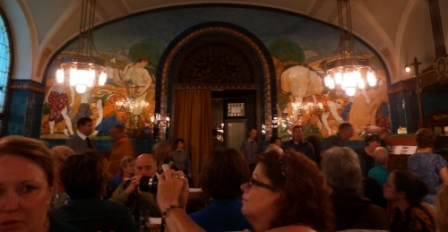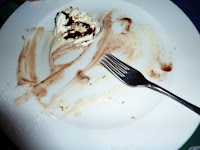 |
| "Nastrovje!" |
Something else, which gave me Heimweh (homesickness) for my time living in Germany to do research, was sleeping with a Bettdecke (comforter). DH is not a fan, because he frequently gets too warm when he sleeps, and these were the real deal. I, however, find them comfortable and snuggly and just regulate my body temperature by increasing or decreasing the number of appendages exposed to the night air.
 We turned in early that night, because we had to pick up our boxed breakfasts in time to get on the bus at 6am to ride to the airport for our flight to our flight to a bus back home. The boxed meal (really more of a lunch, with a cheese sandwich, a meat sandwich, fruit, and juice) couldn't hold a candle to the excellent breakfasts we enjoyed at our hotels. I was actually rather amused at the surprise and delight our trip-mates expressed when they saw the spreads at each new hotel. There was typical cold/European fare: breads and rolls, whole and chopped fruit, meats and cheeses, veggies, yogurt and muesli, hard- or soft-boiled eggs. And there was hot/American fare: scrambled eggs, pancakes, bacon or sausage, hash browns, cereal with milk. We generally can't afford to stay at places with breakfasts as nice as these were--and I snub my nose at American hotels that call coffee, muffins, and some whole fruit a "Continental breakfast"--but I sure do enjoy them when we get the chance. The photo is from Prague, on a morning when I had orange juice, Bircher-Benner muesli with yogurt and rote Grütze (whole sweetened and preserved berries), pink grapefruit slices, and a piece of dark bread with spreadable cheese and a slice of ham. The roll, cucumbers, and salmon salad were for the bus ride to Terezín. DH generally had fruit and some kind of pastry or bread; he tried the pancakes one place and reported they weren't any good, unfortunately.
We turned in early that night, because we had to pick up our boxed breakfasts in time to get on the bus at 6am to ride to the airport for our flight to our flight to a bus back home. The boxed meal (really more of a lunch, with a cheese sandwich, a meat sandwich, fruit, and juice) couldn't hold a candle to the excellent breakfasts we enjoyed at our hotels. I was actually rather amused at the surprise and delight our trip-mates expressed when they saw the spreads at each new hotel. There was typical cold/European fare: breads and rolls, whole and chopped fruit, meats and cheeses, veggies, yogurt and muesli, hard- or soft-boiled eggs. And there was hot/American fare: scrambled eggs, pancakes, bacon or sausage, hash browns, cereal with milk. We generally can't afford to stay at places with breakfasts as nice as these were--and I snub my nose at American hotels that call coffee, muffins, and some whole fruit a "Continental breakfast"--but I sure do enjoy them when we get the chance. The photo is from Prague, on a morning when I had orange juice, Bircher-Benner muesli with yogurt and rote Grütze (whole sweetened and preserved berries), pink grapefruit slices, and a piece of dark bread with spreadable cheese and a slice of ham. The roll, cucumbers, and salmon salad were for the bus ride to Terezín. DH generally had fruit and some kind of pastry or bread; he tried the pancakes one place and reported they weren't any good, unfortunately.The other photos are from the evening of Day 8. After we got back from Ta Fantastica, in the lobby we met other group members planning their alternative day of touring (instead of the trip to Terezín). They had been interested in sampling the local liquors, and I just had to recommend sliwowice (slivovitz). DH and I shared a glass of this Czech plum brandy in honor of my paternal grandfather, whose voice we can both hear in our heads saying, "Nastrovje!" ("Cheers!") Oh, but it buuurns going down. (See before/after snapshots above.)
The journey home was pretty uneventful for us. We were able to find group members willing to trade seats so we could sit together, the plane was not unbearably hot, and no luggage was lost--although I did succumb to a nap between the airport and home. Nevertheless, I had no difficulty falling asleep that night, as I've always found coming back from Europe easier than going over. We've long since unpacked, done loads of laundry, cleaned the house, and moved on. Writing this blog posts was the last thing to do, to chronicle a really wonderful working-vacation.
In conclusion, thank you for reading! It was fun to relive our trip for you. Postings will definitely slow down now, as I'm trying to get a third dissertation chapter drafted by the time classes start in August. Or by Sept. 1. Or Labor Day... Please continue to share here or elsewhere how you and your family are doing. I love to keep in touch.
















































